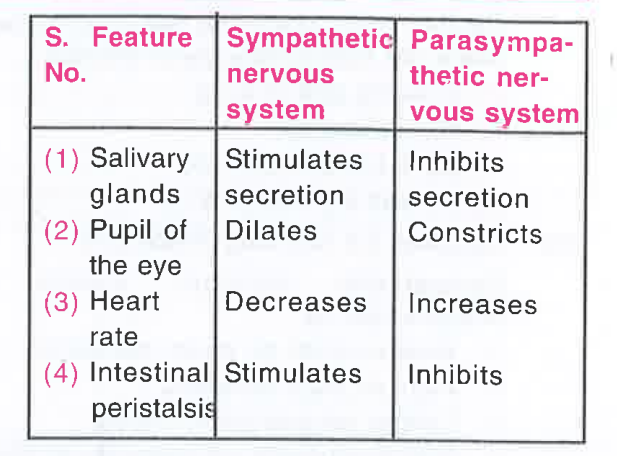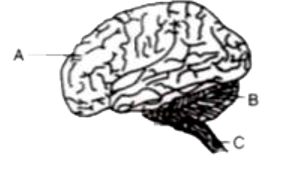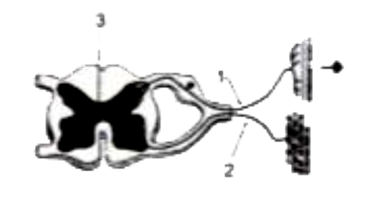Complete Solutions to REVIEW QUESTIONS of chapter NERVOUS SYSTEM of Class 10 book with complete answers and questions
| Class 10 | BIOLOGY |
| Chapter | NERVOUS SYSTEM |
| EVERGREEN PUBLICATION | REVIEW QUESTIONS |
| Number Of Questions | 85 |
| Academic Year | 2023-24 |
Name the following: Neurotransmitter that conducts nerve impulse through synapse.
View SolutionName the following: Part of brain that maintains balance.
View SolutionName the following: Part of nervous system that acts violently during emergency.
View SolutionName the following: lons responsible for the conduction of nerve impulse.
View SolutionName the following: Neurotransmitter that conducts nerve impulse through synapse.
View SolutionName the following: The biological term given to the protective membranes of the brain.
View SolutionName the following: The parts of human brain concernud with
(a) seat of memory (b) coordinates muscular activity.
View SolutionName the following: The parts of human brain concernud with
(a) seat of memory (b) coordinates muscular activity.
View SolutionName the fibre tracts that channel information into and out of the cerebellum.
View SolutionName the following: The fluid that provides protection and nourishment to the cells of the brain.
View SolutionThe cell body of a nerve cell
View SolutionDifferentiate between : Cerebrum and Cerebellum.
View SolutionDifferentiate between : Gray matter and White matter.
View SolutionDifferentiate between : Nerve impulse and Electric current.
View SolutionDifferentiate between : Natural and Conditioned reflex.
View SolutionDifferentiate between : Synapse and Synapsis.
View SolutionDifferentiate between : Cerebrum and Spinal cord (Arrangement of cytons and axons of neurons).
View SolutionDifferentiate between : Spinal and Cranial nerves (Number of nerves)
View SolutionDifferentiate between : Cerebrum and Spinal cord (Arrangement of nerve cell)
View SolutionName various parts of the brain and state functions of each part.
View SolutionDefine the following term : Stimulus.
View SolutionDefine the following term : Response.
View SolutionDefine the following term : Synapse.
View SolutionDefine the following term : Dendrites.
View SolutionDefine the following term : Impulse.
View SolutionWhat do you mean by reflex action? What is its mechanism and significance ?
View SolutionGiven below is a table comparing the effects of sympathetic and parasympathetic nervous system for four feature (1-4). Which one feature is correctly described ?

View SolutionThe following diagram represents the human brain as seen in an external view. Study the same and then answer the questions that follow :

(i) Name the part labelled A, B, C and D.
(ii) Mention the difference in the arrangement of the nerve cells in the parts marked 'A' and 'D'
(iii) What is the main function of the parts marked 'C and 'D'?
(iv) Name the sheet of nerve fibres that connect the two halves of the part labelled.
(v) Name the basic unit of brain.
View SolutionRe-write in correct logical sequence : Dorsal root ganglion, sensory neuron, motor neuron, receptor.
View SolutionRe-write in correct logical sequence : Motor, neuron receptor, sensory neuron, effector, association neuron. (Pathway of nerve impulses)
View SolutionRe-write in correct logical sequence : Spinal cord, Motor neuron, Receptor, Effector, Sensory neuron.
View SolutionRe-write in correct logical sequence : Receptor, Spinal cord, Effector, Motor neuron, Sensory neuron.
View SolutionExplain the term Reflex action.
View SolutionState whether following actions are voluntary action, simple reflex or conditioned reflex.
(1) Blinking
(2) Cleaning the table
(3) Fiaying on the keyboard
(4) Salivating when food is put in the mouth.
View SolutionThe following diagram is that of a human brain. Guidelines 1 to 5 indicate different parts of the surface of the brain and these are as follows:

(1) Frontal lobe of cerebrum.
(2) Temporal lobe of cerebrum
(3) Occipital lobe of cerebrum,
(4) Cerebellum, and
(5) Medulla oblongata.
Study the diagram and answer the following questions:
What handicaps would result from:
(i) damage to part numbered 3 ?
(ii) damage to part numbered 4 ?
View SolutionThe following diagram is that of a human brain. Guidelines 1 to 5 indicate different parts of the surface of the brain and these are as follows:

(1) Frontal lobe of cerebrum.
(2) Temporal lobe of cerebrum
(3) Occipital lobe of cerebrum,
(4) Cerebellum, and
(5) Medulla oblongata.
Study the diagram and answer the following questions:
Mention one main function of each of the parts numbered, 1, 2, and 5.
View SolutionGive technical term to the following:
The point of contact between two neurons.
View SolutionGive technical term to the following:
Protective membranes covering the human brain and spinal cord.
View SolutionGive technical term to the following:
The inflammation of meninges.
View SolutionClassify the following actions as simple reflex or conditioned reflex :
Playing a guitar.
View SolutionClassify the following actions as simple reflex or conditioned reflex :
Removing your hand suddenly when pricked by a thorn.
View SolutionClassify the following actions as simple reflex or conditioned reflex :
Applying sudden brakes when a dog crosses the path.
View SolutionClassify the following actions as simple reflex or conditioned reflex :
Blinking of eyelids on exposure to light.
View SolutionClassify the following actions as simple reflex or conditioned reflex :
Tying one's shoe lace.
View SolutionState whether the following statements are true or false. If false, write the correct form of the statement by changing the first or last word only.
All voluntary actions are controlled by the cerebellum.
View SolutionState whether the following statements are true or false. If false, write the correct form of the statement by changing the first or last word only.
Dilation of pupil is brought about by the sympathetic nervous system.
View SolutionChoose the correct answer to the given statement from the four choices given below the statement:
The cerebral hemispheres in mammals are connected by:
View SolutionChoose the correct answer to the given statement from the four choices given below the statement:
A point of contact between two neurons is termed as
View SolutionSelect the correct statement from the ones given below with respect to dihybrid cross
View SolutionChoose the correct answer to the given statement from the four choices given below the statement:
Which one of the following is mainly associated with the maintenance of the posture ?
View SolutionPick out the correct statement from the following
View SolutionDraw a well labelled diagram of a myelinated Neuron showing the following parts: Perikaryon, Dendrites, Axon, Node of Ranvier and Myelin sheath.
View SolutionState the function of sensory neuron and a motor neuron.
View SolutionWhat is a nerve made-up of ?
View SolutionSelect the odd one out w.r.t haemophilia
View SolutionDuring a street fight between two individuals, mention the effects on the following organs by the autonomous nervous system, in the table given below : (one has been done for you as an example)

View SolutionDraw a well labelled diagram of a 'Neuron' and name the following parts: Node of Ranvier
View SolutionDraw a well labelled diagram of a 'Neuron' and name the following parts: Nissl's granules
View SolutionDraw a well labelled diagram of a 'Neuron' and name the following parts: Cyton
View SolutionComplete the following:
Neurotransmitter : ………………..
View SolutionState the exact location of the following:
Corpus callosum
View SolutionState the exact location of the following:
Myelin sheath.
View SolutionState the exact location of the following:
Corpus callosum
View SolutionGive biological reasons for the following :
The fluid present between the layers of meninges.
View SolutionGive biological reasons for the following :
The change in an organism resulting due to stimulus.
View SolutionGive biological reasons for the following :
Injury to Medulla oblongata results in death.
View SolutionGive biological reasons for the following :
The hand automatically shows the direction to turn a cycle without thinking.
View SolutionWhat is the function of Cerebrospinal fluid ?
View SolutionGive biological reasons for the following :
Injury to Medulla oblongata results in death.
View SolutionGive specific/biological reasons for the following statements.
A person after consuming alcohol walks clumsily.
View SolutionThe statement given below is incorrect. Rewrite the correct statement by changing the underlined words of the statement
Gyri and Sulci are the folds of Cerebellum.
View SolutionThe statement given below is incorrect. Rewrite the correct statement by changing the underlined words of the statement
The outermost layer of Meninges is Pia mater.
View SolutionThe statement given below is incorrect. Rewrite the correct statement by changing the underlined words of the statement
Maintaining balance of the body and coordinating muscular activities is carried by the cerebrum.
View SolutionThe diagram given below is an external view of the human brain. Study the same and answer the questions that follow :

Name the parts labelled A, B and C in the diagram.
View SolutionThe diagram given below is an external view of the human brain. Study the same and answer the questions that follow :

State the main functions of the parts labelled A and B.
View SolutionThe diagram given below is an external view of the human brain. Study the same and answer the questions that follow :

What are the structural and functional units of the brain ? How are the parts of these units arranged in A and C ?
View SolutionThe diagram given below is an external view of the human brain. Study the same and answer the questions that follow :

Mention the collective term for the membranes covering the brain.
View SolutionWhat is the function of Cerebrospinal fluid ?
View SolutionThe diagram given below shows the internal structure of a spinal cord depicting a phenomenon. Study the diagram and answer the questions:

Name the phenomenon that is depicted in the diagram. Define the phenomenon.
View SolutionThe diagram given below shows the internal structure of a spinal cord depicting a phenomenon. Study the diagram and answer the questions:

Give the technical term for the point of contact between the two nerve cells.
View SolutionThe diagram given below shows the internal structure of a spinal cord depicting a phenomenon. Study the diagram and answer the questions:

Name the parts numbered 1, 2 and 3.
View SolutionHow does the arrangement of neurons in the spinal cord differ from that of the brain?
View SolutionMention two ways by which the spinal cord is protected in our body.
View SolutionMatch the items given in Column A with the most appropriate ones in Column B and rewrite the correct matching paris .

View SolutionDifferentiate between : Cerebrum and Spinal cord (Arrangement of cytons and axons of neurons).
View Solution
REVIEW QUESTIONS questions and complete solutions for chapter NERVOUS SYSTEM of EVERGREEN BIOLOGY (ENGLISH) of Class 10